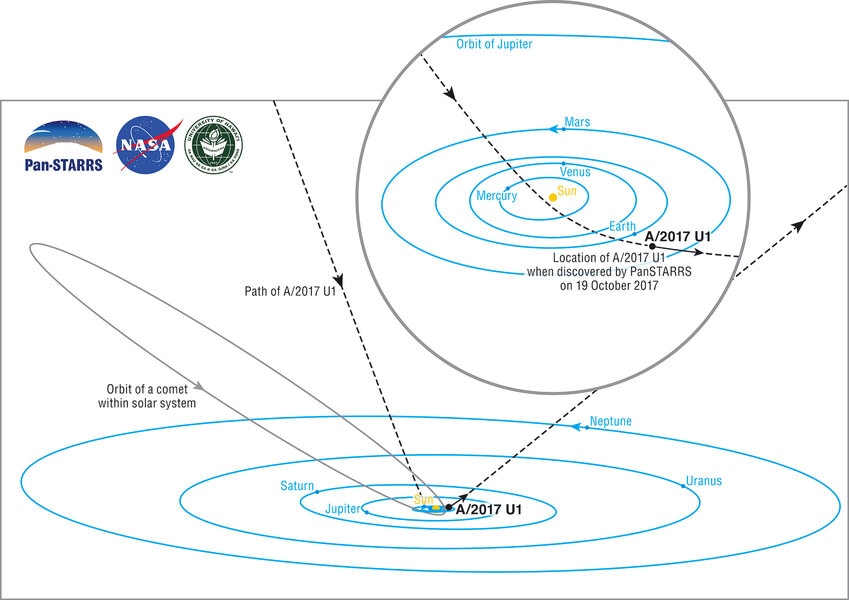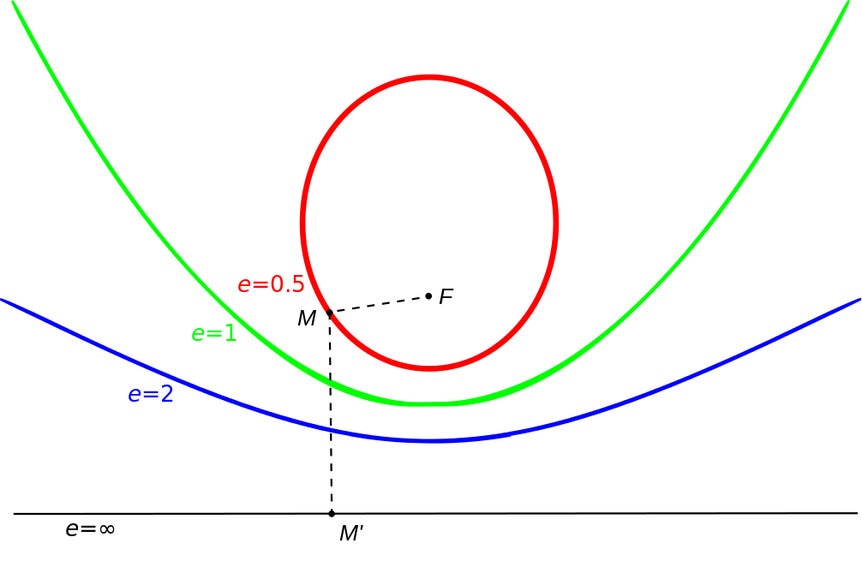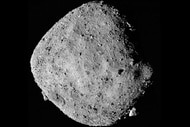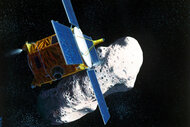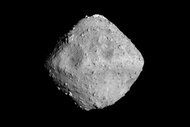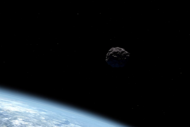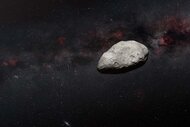Create a free profile to get unlimited access to exclusive videos, sweepstakes, and more!
BREAKING! Have astronomers discovered our first interstellar visitor? NOTE: Not aliens
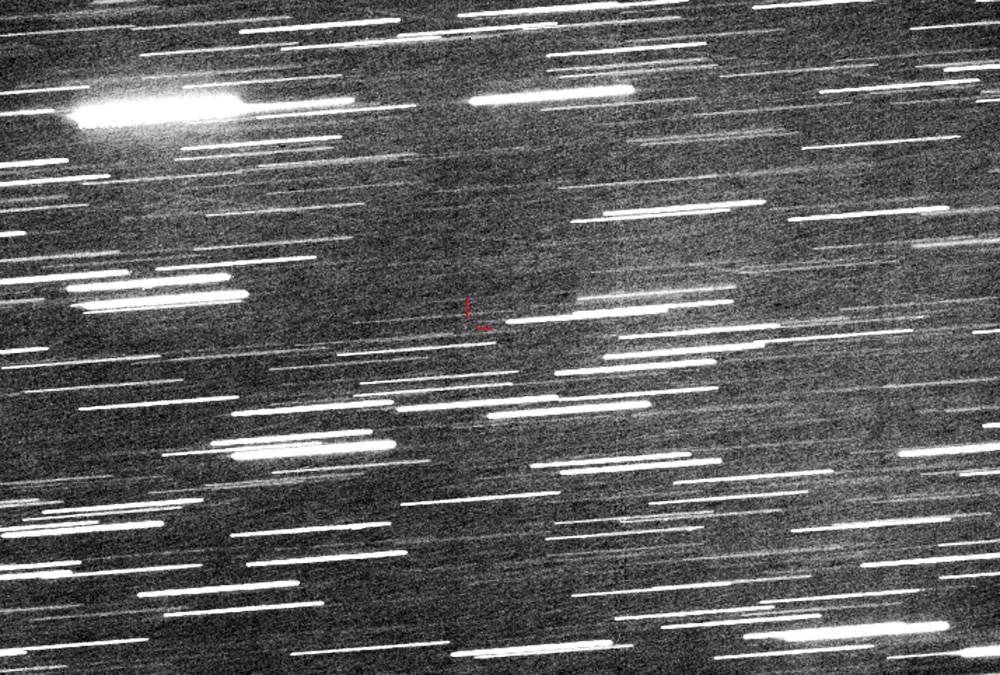
This is a pretty big deal: A newly discovered object currently heading out of our solar system is looking very much like it’s our first true interstellar visitor: an asteroid from another star.
Yes. Seriously.
It’s called A/2017 U1, and it’s probably less than about 400 meters wide. It was discovered just last week, on October 19, in observations made by the Panoramic Survey Telescope and Rapid Response System (Pan-STARRS). This telescope sweeps the skies, looking for moving objects. Right away it looked like this was an unusual object: It was moving too fast.
If an object in the solar system is in a stable, bound orbit around the Sun, its speed depends pretty much on two things: Its distance from the Sun and the shape of its orbit. At the distance of the Earth from the Sun, for example, an object can be moving at anything up to a little over 40 kilometers per second. The Earth orbits in roughly a circle at just under 30 km/sec. An object on an elliptical orbit that stretches as far out as Earth’s orbit will be moving more slowly than that at aphelion (the point in its orbit when its most distant from the Sun).
But if an object is at the same distance as the Earth from the Sun and moving faster than about 42 km/sec, the object is no longer bound to the Sun. This means the object is moving faster than escape velocity (the shape of the orbit is a hyperbola), and will never return. Once it’s gone, it’s gone.
A/2017 U1 passed the Sun inside the orbit of Mercury in early September, curving sharply due to the Sun’s gravity, and is now on its way out. It’s already farther away from the Sun than Earth is, moving at a very brisk 44 km/sec. That’s too fast. It’s not going to come back; it’s heading out into interstellar space*.
How did it get this much speed? Sometimes, objects like comets can get an extra kick by passing by a big planet like Jupiter. But A/2017 U1’s orbit doesn’t bring it near any big planets. In fact, the orbit is tilted to the plane of the solar system by 122°, nearly perpendicular to it. That means it had this huge speed already on its way in.
And that means it must have come from interstellar space. From another star. †
In fact, tracing the orbit backwards, it looks like it came somewhere from the constellation of Lyra, and was already cruising through interstellar space at a speed of over 25 km/sec! At that speed so far out it can’t possibly have an origin inside our solar system, so this is truly an alien object.
Holy wow. I mean, holy wow.
At first it was thought this might be a comet, but very deep images of it show no activity from it at all, no escaping gas or dust. That makes it extremely unlikely to have any ice on its surface, things like frozen water, carbon dioxide, or carbon monoxide, which are usually seen in comets. Instead, it must be rocky or metallic, like an asteroid. At the moment it’s not clear what it’s made of, but a lot of telescopes are being aimed at it; hopefully soon a spectrum may reveal its composition. That’ll be very interesting indeed.
Why is it moving so fast? For quite some time now astronomers have understood that early in the life of the solar system, the big planets have moved around. Jupiter and Saturn were farther out from the Sun and migrated inward. This can disrupt the orbits of smaller objects like comets and asteroids, flinging them about hither and yon. Eventually this cleared a lot of debris from the young solar system, dropping these rocks into the Sun or ejecting them out into interstellar space.
If it happened here, it happened out there, too. The galaxy is probably littered with rogue objects between the stars, the ejecta from birth pangs of alien solar systems. We’ve seen evidence of rogue planets, ejected in a similar way. It’s certain that there is far more smaller debris out there. Finding one of these asteroids passing through our own solar system was just a matter of time.
I’ll note that the direction it’s coming from, Lyra, is in the galactic plane: Where most of the stars in the galaxy are concentrated. That’s consistent; if it’s coming from another star far, far away then somewhere along the Milky Way’s disk is the most likely point of origin.
This is a phenomenal discovery! Stars are very far away; the nearest is over 40 trillion kilometers — a 50,000-year journey at A/2017 U1’s speed. And it certainly came from much farther away yet. It may have been traveling for millions or even billions of years before approaching our system.
Bill Gray of the Pluto Project has been keeping track of the orbital path of this asteroid. I asked him where it appears to be heading, and he told me it’s in the direction of Pegasus (toward a point in the sky with coordinates of RA=23h 51m and Dec=+24° 49', if you’re curious). There aren’t any obvious stars at that spot except for HD 223531, which is 400 light-years away. A/2017 U1 won’t really get all that close to it, and won’t pass it for another million years or more anyway (and by the that time the star will have moved substantially, too).
… still, I can’t help but wonder. I put absolutely no weight on this speculation, and would even bet heavily against it, but it’s an obvious thought and I feel I have to at least mention it.
Space is vast. Even in our solar system, the outer planets are billions of kilometers away, with smaller icy objects extending for a trillion or two past that. No doubt there is debris from other stars passing us at all kinds of distances. Most would never get within a light-year, 10 trillion km.
From that distance, the inner solar system is a ridiculously small target. Mercury’s orbit is only about 115 million km across. For something coming from interstellar space, getting that close to the Sun is threading the eye of a very, very narrow needle.
Yet A/2017 U1 did just that. It passed the Sun at a distance of about 45 million kilometers. That’s … weird.
Part of this is what we call a selection effect: An object like this passing out by the orbit of Jupiter would be very faint, so it’s harder to discover. We only see the ones that happen to pass close to Earth. So even before this, I would’ve wagered the first one we discover would be passing through the inner solar system, as opposed to farther out.
But still, getting that close to the Sun seems unusual.
Let me be clear: I am NOT saying this is an alien spaceship. But if I were an alien race interested in exploring other systems, this is pretty much the sort of path I’d put my probe on. I’d aim it to pass deep within the alien solar system, check out the habitable planets, and use the star’s gravity to bend the orbit to aim it at the next target.
Again, I’m quite sure this is a natural object and not an alien spaceship. Even so, it’s certainly not a mundane one: It’s a freaking asteroid ejected from another star that’s been wandering the galaxy for eons and passed a few million kilometers from the Sun and Earth and is on its way back out into the void!
Either way, I wish Arthur C. Clarke had lived to see this. He’d have loved it.
* The shape of an orbit is described by its eccentricity, which you can think of as how far it deviates from a circle. An eccentricity of 0 is a perfect circle, and ellipses have eccentricities up to 1. A parabola has an eccentricity of exactly 1, and anything greater than 1 is a hyperbola. A/2017 U1 has an eccentricity of about 1.2. At first there weren’t enough observations to be sure about that, but now there are so many that the uncertainty in the eccentricity is less than 0.003. It’s hyperbolic for sure. Staggering.
†There’s another possibility: If there’s another planet in our solar system orbiting far, far beyond Neptune, and the asteroid started somewhere nearby (that is, as part of our solar system since the start) and passed close to this planet, it could get a kick in velocity and get flung down towards us at higher speed. However, a lot of things have to line up for this to happen so the odds on this are incredibly low, so low I’d put them at essentially 0. But I’d be remiss not to at least mention it. [UPDATE (Oct. 29, 2017): Bill Gray (mentioned in the article) sent me a note; he points out that even if such an encounter happened, it's essentially impossible for it to give a kick to the asteroid large enough to get it moving at 25 km/sec, the excess speed U1 was moving when it was still far from the Sun. I agree, so ignore this footnote!]
